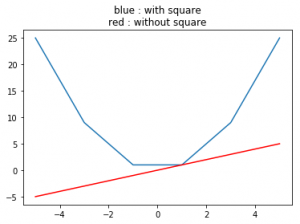numpy.square() in Python
Last Updated :
23 Feb, 2023
numpy.square(arr, out = None, ufunc ‘square’) : This mathematical function helps user to calculate square value of each element in the array. Parameters :
arr : [array_like] Input array or object
whose elements, we need to square.
Return :
An array with square value of each array.
Code #1 : Working
Python3
import numpy as np
arr1 = [1, -3, 15, -466]
print ("Square Value of arr1 : \n", np.square(arr1))
arr2 = [23 ,-56]
print ("\nSquare Value of arr2 : ", np.square(arr2))
|
Output :
Square Value of arr1 :
[ 1 9 225 217156]
Square Value of arr2 : [ 529 3136]
Code #2 : Working with complex numbers
Python3
import numpy as np
a = 4 + 3j
print("Square(4 + 3j) : ", np.square(a))
b = 16 + 13j
print("\nSquare value(16 + 13j) : ", np.square(b))
|
Output :
Square(4 + 3j) : (7+24j)
Square value(16 + 13j) : (87+416j)
Code #3 : Graphical Representation of numpy.square()
Python3
import numpy as np
import matplotlib.pyplot as plt
a = np.linspace(start = -5, stop = 5,
num = 6, endpoint = True)
print("Graphical Representation : \n", np.square(a))
plt.title("blue : with square\nred : without square")
plt.plot(a, np.square(a))
plt.plot(a, a, color = 'red')
plt.show()
|
Output :
Graphical Representation :
[ 25. 9. 1. 1. 9. 25.]
 References : https://docs.scipy.org/doc/numpy-1.13.0/reference/generated/numpy.absolute.html .
References : https://docs.scipy.org/doc/numpy-1.13.0/reference/generated/numpy.absolute.html .
using for loop:
In this example, we define a list of numbers called numbers. We then use a for loop to iterate over each number in the list, and calculate the square of each number using the exponentiation operator **. We store each square in a new list called squares. Finally, we print the list of squares to the console.
Note that this approach is not as efficient or concise as using the numpy.square() function, especially if you are working with large arrays of numbers. However, it can be useful if you need to implement your own custom square function or want to understand how the numpy.square() function works internally.
Python3
numbers = [1, 2, 3, 4, 5]
squares = []
for number in numbers:
square = number ** 2
squares.append(square)
print("The squares of the numbers are:", squares)
|
Output
The squares of the numbers are: [1, 4, 9, 16, 25]
Approach:
The code defines a list of integers numbers. It then calculates the square of each number in numbers using a for loop, and stores the results in a new list called squares. Finally, the squares of the numbers are printed.
Time Complexity:
The time complexity of the list comprehension is also O(n), where n is the length of the input list numbers. Therefore, the time complexity of both the original code and the alternative code is O(n).
Space Complexity:
The space complexity of the original code and the alternative code is also O(n), because they both create a new list squares to store the results of the square operation, which has the same length as numbers. Additionally, they both use some auxiliary space to store the loop variable and the temporary result of each square operation.
Share your thoughts in the comments
Please Login to comment...